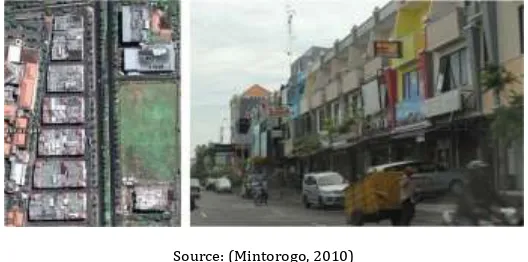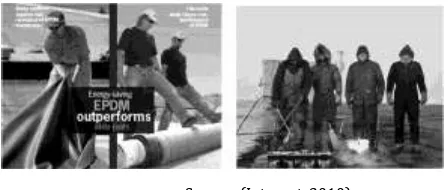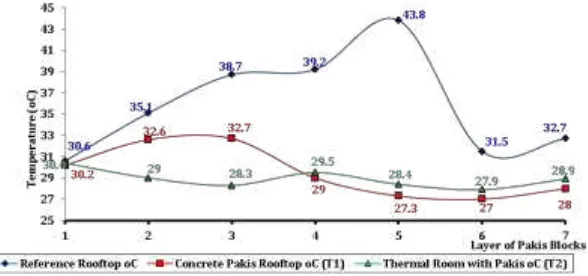B2-53
Pakis-Stem Blocks as Natural Heat Insulation Diminished Room Thermal
in Surabaya
Danny Santoso Mintorogo1 and Mohd. Hamdan Ahmad2
1 Department of Architecture/Faculty of Engineering and Planning, Petra Christian University, Indonesia 2Department of Architecture/Faculty of Built Environment, Universiti Teknologi Malaysia, Malaysia
Email address of corresponding author: dannysm@peter.petra.ac.id
ABSTRACT
In the era of sustainable architecture where global warming is happen every time and day in many countries, flat concrete rooftop heat insulation has to be installed to diminish the thermal heat piercing onto the room. The research is concentrated to the thickness of Pakis-stem block layers that could obstruct as low as possible of solar heat radiation piercing onto the room. By providing two flat concrete rooftop models, the bare rooftop thermal and Pakis-stem blocks rooftop thermal performances could be monitored. The outcome of the thermal performance of pakis stem blocks cover is crucial to lower the room temperature. The lower heat room thermal coming from rooftop will lead to energy saving domain.
© 2011 12th SENVAR. All rights reserved.
Keywords: Pakis-stem blocks, natural heat insulation, room thermal
1. Introduction
Sustainable architecture buildings are the preferred topic to be discuss all the time now just because the world has been facing critical energy catastrophe. One of factors that causing great demand of energy in air conditioning buidlings is the solar heat sun radiation piercing through windows, curtain-glass walls and impacted on roofs in any place in the world. According to Nazar et al. (2003) that roofs on single buildings donate almost 36,7% of solar heat radiation into the buildings even to 50% of solar thermal heat comes from flat rooftop (Nazar et al. 1999). The roof will receive the greatest heat radiant impacted than other parts of the building façade. Flat concrete rooftop will receive an average of solar irradiation of 396 Wh.m-2 on dry seasons
and 363 Wh.m-2 on wet seasons of Surabaya’s climate (Mintorogo 2008). Sun’s ray along with heat solar
radiation will produce thermal heat on a surface that is absorbed or reflected by roof materials. Absorbed solar radiation will increase the outer surface temperature of the roof by 30 to 40oC (Adamson 1993). Based
on Surabaya’s weather station report that yearly average of outdoor maximum temperature and minimum
temperature in 2008 are 33.9oC and 22.1oC (Weather Station of Juanda Surabaya 2008).
Source: (Mintorogo, 2010)
Surabaya with latitude of 7o 17-21’S, on year 1995 till now, lots of business placeses are needed but
middle-class businessmen or presetting business firms can’t afford to pay on high-cost rental space buildings. Therefore, single-houses, town-houses, shop-houses, and even dwellings along the main street become favorite placeces to choose. A lots of new town, shop, and office houses are to be built to two or three stories with majority of flat rooftop concrete of around 12,400 m2 at Manyar Kertoarjo street (figure 1). Nan of external insulations are put on concrete rooftop; only water proofing paint is aplied to those flat concrete roofs.
Applying rows of pieces of Pakis blocks over the flat rooftop concrete as external enveronmental friendly insulation, the room thermal will be controlled diminishly. Pakis-stem blocksl are used by orchid flower users that they attach the orchids on Pakis block and Pakis blocks are sold at flower shops. Those Pakis blocks come from Pakis trees which could be found at the jungle; the Pakis stem is then be sliced onto pieces of Pakis blocks.
Source: (Mintorogo, 2010)
Figure 2: Pakis Trees, Pakis-Stem Blocks, and Orchid on Pakis Block
2. Literature Review
Many researchers and scholars have researched and carried out many applications to block or diminish the impact of solar heat radiation to room thermal from flat concrete rooftop; the applicantions are: roofpond and its alteration, green roofs or rooftop gardens, cool roofs (insulation), and double roofs.
2.1 Roofpond
In accordance with Mintorogo and Wanda (2011) research, roofpond on tropical and humid climate of Surabaya could play a great role to diminish the room thermal on daytime mode all year round with compare to bare flat concrete rooftop; room thermal temperatures diffrent on critical months of March, June, September and December are 1,4oC, 1,1oC, 2,5oC and 1,1oC respectively. However roofpond room thermal
performance become worse on nighttime mode, the water on roofpond could not cold repeatly with compare to bare concrete roof to cool night sky radiation; the room temperatures different to flat concrete roof are 0oC
on March, 0,1oC on June and September, 0,3oC on December.
2.2 Green Roofs or Roof Gardens
Green roofs or Rooftop gardens have two kinds of greenery roof systems that are extensive and intensive green roofs. Extensive green roof characteristic is not to design for public excess, it is merely for aesthetic and ecological environment proposes, low-cost due to lightweight construction, low maintenance, thin layer of soil, and smaller vegetation (merely bushes). Contradictory to extensive green roofs, intensive green roofs are designed for public excess-way or roof garden-playground on rooftop parking buildings, high plants (scrubs or trees), thick substrate, heavyweight construction, and high maintenance (Wong 2006, Czemiel Berndtsson 2010).
Tested on intensive roof garden landscaping on low-rise commercial building, the maximum hard surface temperature (without soil and plants) at 2 pm is 57oC; the maximum bare soil surface temperature is 42oC.
B2-55 With extensive rooftop garden, the maximum temperature on metal roof is 60o– 70oC. By providing plants
or vegetation, the maximum temperature below the dense plants is 35.1oC. But the metal roof has the faster
cooling effect at night among the other roof materials. Moreover metal roof is lightweight structure and has a low maintenance factor.
2.3 Coolroofs
Coolroof was invented by Dick Bourne in 1980, Davis, California. This system uses concrete roof as roof pond with impermeable floating insulation panels in water; the water is then pumped over the insulation during the night in order to have long-wave sky radiation cooled the water. The cooling water temperature could be around 1-2oK above the average ambient WBT, and the ceilling temperature (exposed concrete) would have
about 2oK over the water temperature (Givoni 1994). An indoor temperature of 25oC would be obtained with
the maximum outdoor temperature of 37oC during the daytime; the water pond temperature will fluctuate a
round 5oC (Givoni 1994).
2.4 Bittumen Roll Roofing Sheet
Single-ply Rubber Membrane Roofing. (EPDM): Ethylene Propylene Diene PolyMethylene is applied to flat rooftop concrete to give great protection to solar radiation through roof. It is great rubber roofing sheet but it is not environmental friendly insulation material (figure 3).
Source: (Internet, 2010)
Figure 3: Applying Single-ply Rubber Membrane Roofing. (EPDM)
3. Methodology
The research is an experimental work sited on Petra University’s flat concrete rooftop. The data are recorded weekly and simultaneously on two models with digital logger of HOBO. The recorded data are: rooftop flat concrete temperature for reference model and Pakis blocks model (T1); room thermal temperature for both reference and Pakis blocks covered model (T2); shaded outdoor temperature and relative humidity.
3.1 The models
The models are structure with steel frame and covered with 3 mm of “Calsiboard” on outside walls then
Source: (Mintorogo, 2010)
Figure 4: A. The model, B. Covered model with Pakis-stem Blocks
3.2 The Measuring Tools
The HOBO data loggers and sensors are U 12 type used for measuring temperatures and relative humidity; the maximum and minimum temperature ranges are 60oC to – 5oC.
4. Results and Discussions
The rooftop concrete temperatures at reference model fluctuate greatly from the lowest temperature of 30.6oC to maximum 43.8oC. Contradictory to the model covered with Pakis-stem blocks, the rooftop concrete
temperatures vary slightly from 30.2oC on one layer of Pakis blocks to 28oC with 7 layers of Pakis blocks on
flat rooftop concrete. The Pakis-stem blocks rooftop temperatures go up and down along with layers of Pakis blocks covered and the local climatic insolence. The room thermal performances (green line) happened contrary to Pakis blocks rooftop temperature (red line) ranging from one to four layers of Pakis blocks (for instant: 32.6oC to 29oC on 2nd layer Pakis blocks covered) (figure 5). With five to six layers of Pakis blocks
covered (cooler rooftop temperature), room thermal goes above rooftop temperature; meaning that there are other thermal piercing through walls than roof. Applying with four layers of Pakis blocks (12cm), room thermal temperature gets almost even with rooftop temperature.
Source: (Mintorogo, 2010)
Figure 5: Divergence of Reference Model Rooftop, Pakis Covered Rooftop Temperatures and Room Thermal with Layering of Pakis Blocks
B2-57 insulation to prevent over heated on flat concrete rooftop. Applying five layers of Pakis blocks would be the better solution to minimize rooftop temperature.
Table 1: Thermal Differences for Flat Rooftop vs Room Temperatures
Layer of Pakis Blocks OutdooroC Concrete Rooftop oC (T1) RoomoC (T2) Thermal Difference (T1-T2)
1 (3 cm) 29.8 30.2 30.4 -0.2
Daytime rooftop thermal performances illustrate the rooftop received solar sun heat radiation on bare concrete roof (the reference model—default flat concrete rooftop) and insulated heat temperature on Pakis-stem blocks-cover flat concrete rooftop. Meanwhile thermal performances on nighttime indicate the
responsive of concrete rooftop to radiate the roof thermal heat to cool night sky radiation “skytherm concept”.
Table 2 shows the room thermal performance on daytime and nighttime with different layers of Pakis-stem blocks covered. The room thermal performances are diverse slightly between the reference and the Pakis blocks covered model on nighttime mode. From 0.2oC to 0.7oC differences on one to seventh layers of Pakis
blocks rooftop at nighttime, the room temperatures of Pakis-stem blocks rooftop model are hotter than reference model.
Room thermal performance with Pakis-stem blocks covered model is cooler than the room thermal on reference model at daytime; the temperature different between reference model with Pakis blocks model on daytime from layer 1 to 7 are 1.1oC, 2.2oC, 1.9oC, 2.2oC, 4.2oC, 4.4oC and 4.1oC respectively.
Table 2: Depth of Layering Pakis-Sterm Blocks Room Temperatures
REFERENCE MODEL (Default) PAKIS-STEM BLOCKS MODEL
Flat rooftop concrete covered with layers of natural heat insulation (environmental friendly material) of Pakis-stem blocks have approved to diminish roof and room thermal significantly. Simply applying with four to five layers of Pakis-stem blocks, the room thermal temperature will be cut down to 2.2oC with four layers)
and 4.2oC with five layers. Room thermal temperature is closed to tropical natural thermal comfort of 28.5oC.
Acknowledgement
I acknowledge to the department of architecture, Petra Christian University for providing both measurement tools and fund to this research of natural heat insulation for flat concrete rooftop.
References
Adamson, B., Olle, A (1993) Design for Climatization; Houses in Warm-Humid Areas. Building Issues, Vol. 5, No. 1.
Mintorogo, Danny S. (2008), Horizontal dan Vertical Intensitas Solar Radiasi Matahari di Surabaya.
Czemiel Berndtsson, J. (2010) Green Roof Performance Towards Management of Runoff Water Quantity and Quality: A Review. Ecological
Engineering, doi:10.1016/j.ecoleng.2009.12.014.
Givoni, Baruch (1994) Passive and Low Energy Cooling of Buildings. Van Nostrand Reinhold, New York.
Nahar NM et al. (1999). Sudies on Solar Passive Cooling Techniques for Arid Areas. Energy Conversion & Management; 38 p.89-95
Nahar NM, et al. (2003). Performance of Different Passive Techniques for Cooling of Buildings in Aris Regions. Building and Environment;
38 p.109-16
Tjahjono, Endro. (2008). Weather in Juanda Surabaya. Surabaya.
Wong, N.H., Chen, Y. (2006) A Comparison of Two Rooftop Systems in the Tropical Climate. In: Proceeding of the INTA 2nd Harmony in



